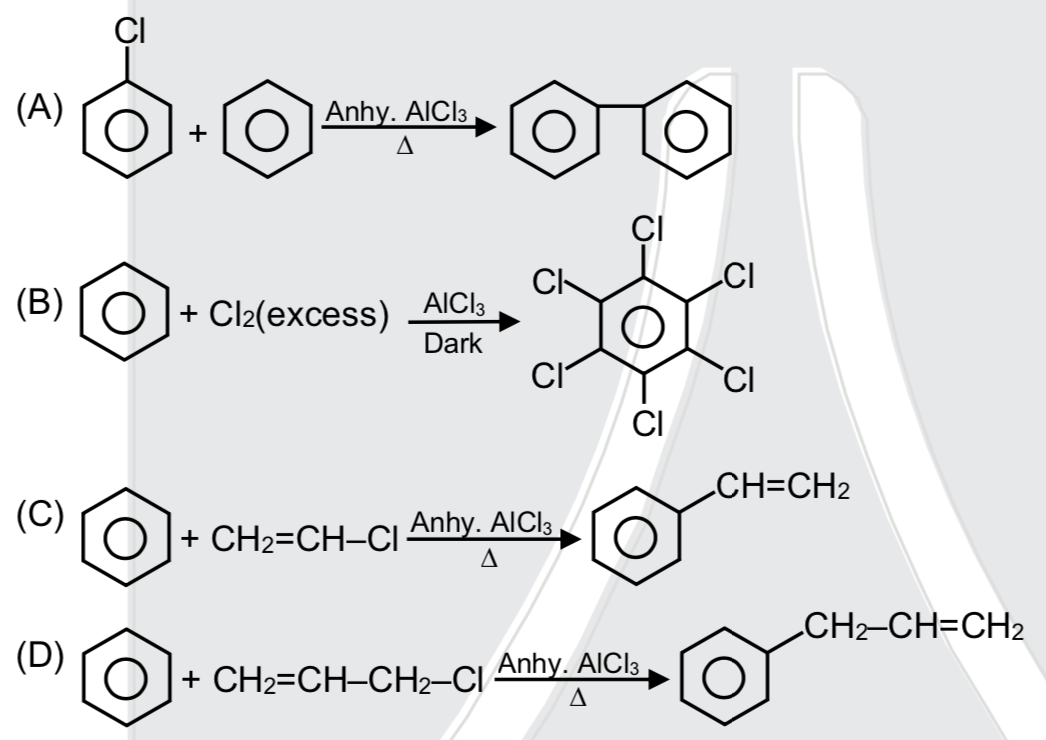Which of the following equations, pick out the possible nuclear fusion reactions?
.136C+.11H→.146C +4.3 MeV
.126C+.11H→.137N + 2 MeV
.147N+.11H→.158O + 7.3 MeV
.23592U+.10N→.14054Xe+.9438Sr+.10n+.10n + 200 MeV
The correct Answer is:b and d
To determine which of the given equations represent possible nuclear fusion reactions, we first need to understand what a nuclear fusion reaction is. A nuclear fusion reaction occurs when two lighter atomic nuclei combine to form a heavier nucleus, releasing energy in the process.
Now, let's analyze each option step by step:
Step 1: Analyze the First Option
Reaction: An isotope of carbon (C-13) combines with a hydrogen atom (H-1) to produce C-14 and energy.
- Mass Number Check:
- Reactants: C-13 (mass number 13) + H-1 (mass number 1) = 14
- Products: C-14 (mass number 14)
- Mass number is conserved.
- Atomic Number Check:
- Reactants: C (atomic number 6) + H (atomic number 1) = 7
- Products: C (atomic number 6)
- Atomic number is not conserved (6 + 1 ≠ 6).
Conclusion: This reaction is not a valid nuclear fusion reaction due to the violation of atomic number conservation.
Step 2: Analyze the Second Option
Reaction: C-12 combines with H-1 to produce nitrogen (N-13) and energy.
- Mass Number Check:
- Reactants: C-12 (mass number 12) + H-1 (mass number 1) = 13
- Products: N-13 (mass number 13)
- Mass number is conserved.
- Atomic Number Check:
- Reactants: C (atomic number 6) + H (atomic number 1) = 7
- Products: N (atomic number 7)
- Atomic number is conserved (6 + 1 = 7).
Conclusion: This reaction is a valid nuclear fusion reaction.
Step 3: Analyze the Third Option
Reaction: A nitrogen atom (N-14) combines with a hydrogen atom (H-1) to produce an isotope of oxygen (O-15).
- Mass Number Check:
- Reactants: N-14 (mass number 14) + H-1 (mass number 1) = 15
- Products: O-15 (mass number 15)
- Mass number is conserved.
- Atomic Number Check:
- Reactants: N (atomic number 7) + H (atomic number 1) = 8
- Products: O (atomic number 8)
- Atomic number is conserved (7 + 1 = 8).
Conclusion: This reaction is a valid nuclear fusion reaction.
Step 4: Analyze the Fourth Option
Reaction: A uranium atom (U-235) combines with a neutron to produce two lighter atoms.
- Nature of Reaction:
- This reaction involves a heavy nucleus splitting into lighter nuclei, which is characteristic of nuclear fission, not fusion.
Conclusion: This reaction is not a nuclear fusion reaction.
Final Conclusion
The possible nuclear fusion reactions from the options provided are:
- Option 2: C-12 + H-1 → N-13 + energy
- Option 3: N-14 + H-1 → O-15 + energy
Summary of Valid Options
- Valid Fusion Reactions: Option 2 and Option 3
- Invalid Fusion Reactions: Option 1 and Option 4
Reaction: An isotope of carbon (C-13) combines with a hydrogen atom (H-1) to produce C-14 and energy.
- Reactants: C-13 (mass number 13) + H-1 (mass number 1) = 14
- Products: C-14 (mass number 14)
- Mass number is conserved.
- Atomic Number Check:
- Reactants: C (atomic number 6) + H (atomic number 1) = 7
- Products: C (atomic number 6)
- Atomic number is not conserved (6 + 1 ≠ 6).
Reaction: C-12 combines with H-1 to produce nitrogen (N-13) and energy.
- Reactants: C-12 (mass number 12) + H-1 (mass number 1) = 13
- Products: N-13 (mass number 13)
- Mass number is conserved.
- Reactants: C (atomic number 6) + H (atomic number 1) = 7
- Products: N (atomic number 7)
- Atomic number is conserved (6 + 1 = 7).
Reaction: A nitrogen atom (N-14) combines with a hydrogen atom (H-1) to produce an isotope of oxygen (O-15).
- Reactants: N-14 (mass number 14) + H-1 (mass number 1) = 15
- Products: O-15 (mass number 15)
- Mass number is conserved.
- Reactants: N (atomic number 7) + H (atomic number 1) = 8
- Products: O (atomic number 8)
- Atomic number is conserved (7 + 1 = 8).
Reaction: A uranium atom (U-235) combines with a neutron to produce two lighter atoms.
- This reaction involves a heavy nucleus splitting into lighter nuclei, which is characteristic of nuclear fission, not fusion.
The possible nuclear fusion reactions from the options provided are:
- Option 2: C-12 + H-1 → N-13 + energy
- Option 3: N-14 + H-1 → O-15 + energy
- Valid Fusion Reactions: Option 2 and Option 3
- Invalid Fusion Reactions: Option 1 and Option 4
Topper's Solved these Questions
- NUCLEIBOOK - NCERT FINGERTPS ENGLISHCHAPTER - NUCLEIEXERCISE - HOTS
7 Videos
- NUCLEIBOOK - NCERT FINGERTPS ENGLISHCHAPTER - NUCLEIEXERCISE - EXEMPLAR PROBLEMS
7 Videos
- MOVING CHARGES AND MAGNETISM BOOK - NCERT FINGERTPS ENGLISHCHAPTER - MOVING CHARGES AND MAGNETISM EXERCISE - Assertion And Reason
15 Videos
- PRACTICE PAPPERBOOK - NCERT FINGERTPS ENGLISHCHAPTER - PRACTICE PAPPEREXERCISE - Practice Paper 3
50 Videos
Similar Questions
Knowledge Check
Which of the following reaction is possible ?
AC6H5OH+HBr→C6H5Br+H2OB(CH3)3CCl+NaOCH3→(CH3)3COCH3+NaClC D
D
Which of the following reaction is possible ?
AC6H5OH+HBr→C6H5Br+H2OB(CH3)3CCl+NaOCH3→(CH3)3COCH3+NaClC D
D
Which of the following reaction is possible ?
AC6H5OH+HBr→C6H5Br+H2OB(CH3)3CCl+NaOCH3→(CH3)3COCH3+NaClC D
D
An example of nuclear fusion reaction is
View SolutionWhich of the following reaction is possible ?
View SolutionWhich of the following reactions is / are possible at the anode ?
View SolutionWhich of the following reactions are possible ?

View SolutionWhich of the following reactions are possible ?

View Solution
